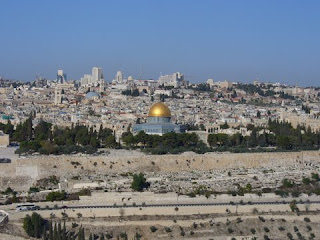The Room of the Last Supper was very simple, undecorated room on the upper level of a church built by the Crusaders. I personally didn't find anything special about any of the three stops.
Our tour of the Holyland ended with a stop that we will all remember for the rest of our lives - the Garden Tomb.
While there are stops on the Via Dolorossa that commemorate possible sites of Jesus' crucifixion, burial and resurrection, the Garden Tomb is another site that could have been the site for all three. During excavations many years ago, archaeologists discovered a large rock in the side of a cliff that looks like a skull (Golgotha). According to the Bible, the place where Jesus was crucified was called Golgotha.
There is also evidence that the location was previously a garden. Later, a series of Jewish tombs (burial caves) were found here, including some for 'wealthier' individuals. Remember, a wealthy man, Joseph of Aramathea, offered up his burial tomb for Jesus.
Anyway, our guide gave us an excellent description of the site - which opposed to the iconic churches is indeed a very quiet and peaceful garden - and its ties to the Bible. As we listened to his powerful explanations, other groups nearby were holding worship services - singing hymns and partaking in communion. Our guide reminded us, 'Don't worry that the tomb is empty. He is risen,' and 'We don't worship a dead teacher, we worship a risen Saviour.'
We went down to an empty tomb.
It was a very emotional experience for all of us, and the ultimate way to end our tour of the Holyland.



















